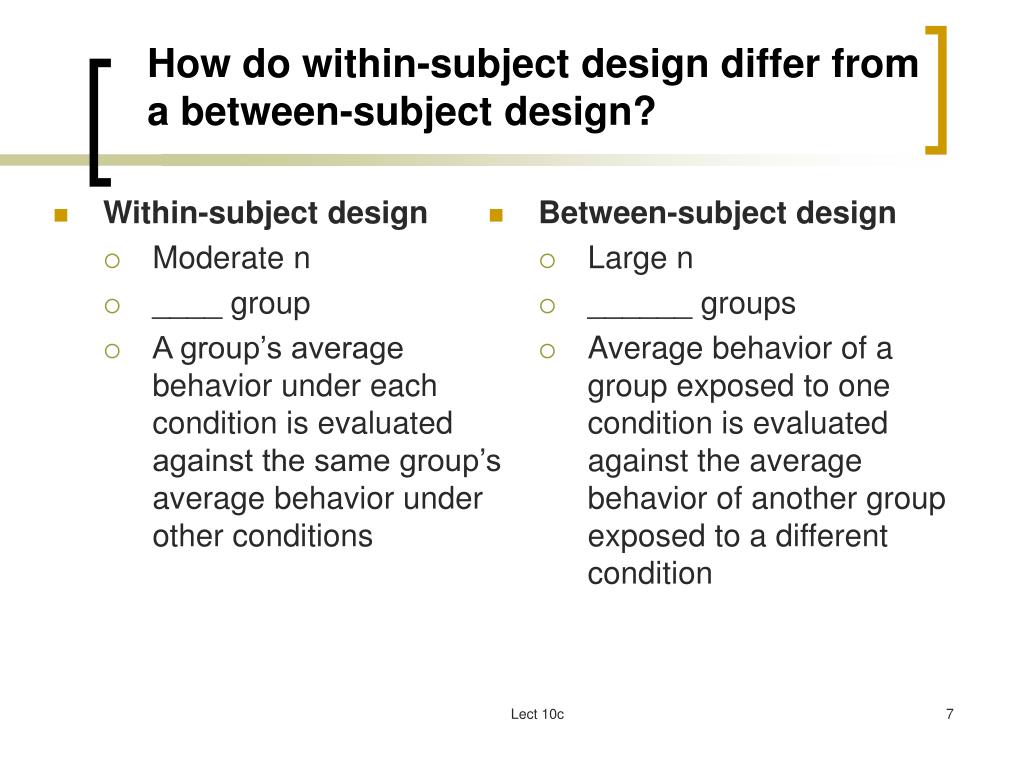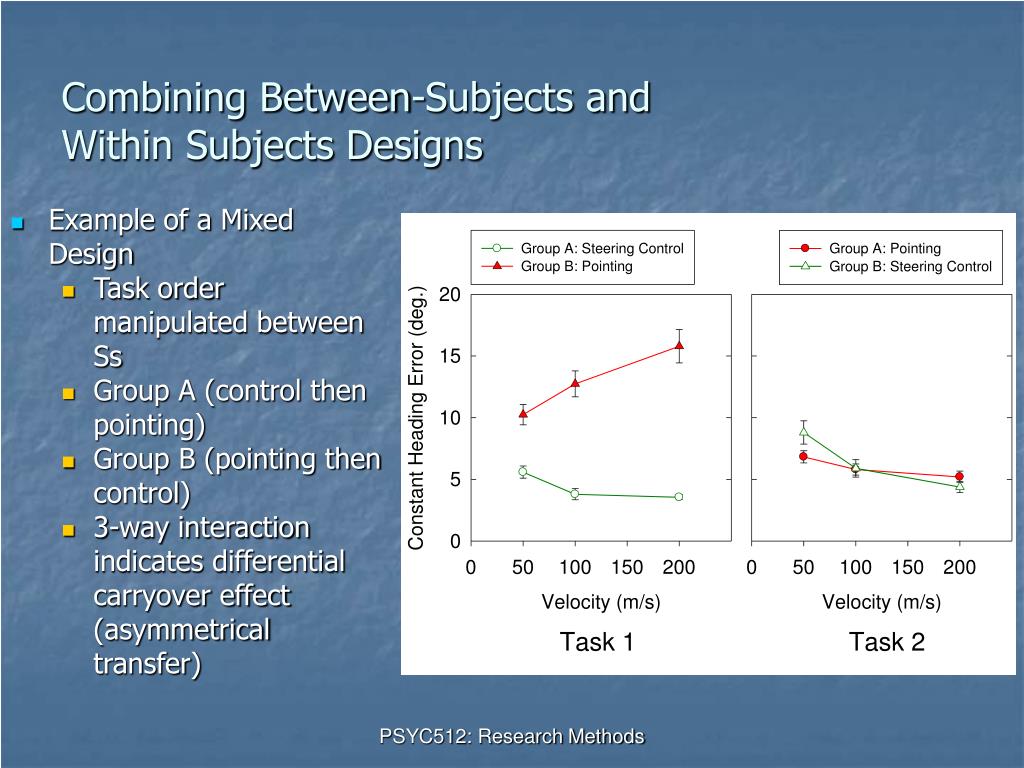Table Of Content
- Switching Replication with Treatment Removal Design
- Familiarity, but not Recollection, Supports the Between-Subject Production Effect in Recognition Memory
- Mixed factorial design
- Individual Differences
- Non-Manipulated Independent Variables
- Experiment 2b: Between-Subject Design With Confidence Ratings
- Between-subjects study design

Following Ozubko et al. (2012), participants were asked to use each of the numbers on the scale at some point during the test phase. Similarly, in the example of examining the effects of taking attendance on student absences in a research methods course, the design could be improved by using students in another section of the research methods course as a control group. A between-subjects design would require a large participant pool in order to reach a similar level of statistical significance as a within-subjects design. This key characteristic would be the independent variable, with varying levels of the characteristic differentiating the groups from each other. Thanks to this approach, we will place each subject in equal conditions to get into one of the groups. And naturally, this will require a lot more people than with any other method described above.
Switching Replication with Treatment Removal Design

The advantages we can attribute to the fact that using this method, we avoid the effect of fatigue or any other factor that will establish order in testing. This is achieved due to the fact that each subject participates in only one test condition. There are several factors to consider when deciding whether to implement the subject design. We formed groups with random participants to ensure comparability of the initial characteristics of the participants across the groups. You apply a similar experiment to all the participants in each group and compare the sleep hours at the end. Ideally, your participants should be randomly assigned to one of the groups to ensure that the baseline participant characteristics are comparable across the groups.
Familiarity, but not Recollection, Supports the Between-Subject Production Effect in Recognition Memory
Or imagine an experiment designed to see whether people with social anxiety disorder remember negative adjectives (e.g., “stupid,” “incompetent”) better than positive ones (e.g., “happy,” “productive”). The researcher could have participants study a single list that includes both kinds of words and then have them try to recall as many words as possible. The researcher could then count the number of each type of word that was recalled. There are many ways to determine the order in which the stimuli are presented, but one common way is to generate a different random order for each participant.
Mixed factorial design
Another reason is that even if random assignment does result in a confounding variable and therefore produces misleading results, this confound is likely to be detected when the experiment is replicated. In a within-subjects experiment, however, the same group of participants would judge the guilt of both an attractive and an unattractive defendant. The primary distinction we will make is between approaches in which each participant experiences one level of the independent variable and approaches in which each participant experiences all levels of the independent variable.
The subjects are placed in identical test conditions, where they will need to rebuild in terms of use with each new step. Stages are called the change of subjects (in our case, these are users) when tasks are performed in one condition, making participation in another state impossible. Setting up experiments to test the usability of multiple user interfaces and conducting user surveys requires some planning. One consideration is whether to choose interval research or use an interdisciplinary research approach.
In other words, recollection itself may begin to break down in situations where stimuli are too similar to one another. In terms of the production effect, producing every item (as done in a between-subjects design) may cause encoding of the distinctive elements of the produced items to fail, rendering a distinctiveness-based recollection strategy ineffective. Within-subjects study designs typically have higher statistical power than between-subjects study designs. In other words, the effect of the independent variables on the dependent variable is more effectively detected in this type of experiment.

There are two ways to rule out the possibility of selection bias in a between subjects design. The first is to equalize the potentially significant variables; below we will look at the pros and cons of equalization. The apparent disadvantage of the intersubjective design is the possibility of selection bias.
Experiment 2b: Between-Subject Design With Confidence Ratings
A between-subjects study design aims to enable researchers to determine if one treatment condition is superior to another. Researchers will manipulate an independent variable to create at least two treatment conditions and then compare the measures of the dependent variable between groups. In the between subjects design, we have only one independent variable, and in the case of the user interface, this can be a classic design, which you can read about in our blog. Experiment 3 also examined a methodological issue regarding design effects in the production literature. Namely, participants in a typical within-subjects production experiment read aloud half as many words as a participant in a pure aloud condition of an otherwise matched between-subjects production experiment.
One-Way vs Two-Way ANOVA: Differences, Assumptions and Hypotheses - Technology Networks
One-Way vs Two-Way ANOVA: Differences, Assumptions and Hypotheses.
Posted: Fri, 20 Jul 2018 07:00:00 GMT [source]
The top group is the experimental group and the bottom group is the control group. Between-subjects cannot be used with small sample sizes because they will not be statistically powerful enough. Within-subjects are typically used for longitudinal studies or observational studies conducted over an extended period.
One can analyze the data separately for each order to see whether it had an effect. A between-subjects study design, also called independent groups or between-participant design, allows researchers to assign test participants to different treatment groups. It is therefore important to also consider whether a single-process account would provide a more parsimonious explanation of our results (e.g., Wixted, 2007; Wixted & Stretch, 2004). Imagine, for example, that students in one school are given a pretest on their attitudes toward drugs, then are exposed to an anti-drug program, and finally, are given a posttest. Students in a similar school are given the pretest, not exposed to an anti-drug program, and finally, are given a posttest. Again, if students in the treatment condition become more negative toward drugs, this change in attitude could be an effect of the treatment, but it could also be a matter of history or maturation.
In addition to this, being only exposed to a single condition means the testing session can be shorter, have a simpler set-up, and decrease the likelihood of fatigue affecting the results. The choice of experimental design will affect the type of statistical analysis that should be used on your data. Between-subject and within-subject designs can be combined in a single study when you have two or more independent variables (a factorial design). In a between-subjects design, there is usually a control group and an experimental group, with each participant experiencing one of these conditions.
Because each subject is assigned to only one condition, this type of design requires a large sample. Thus, these studies also require more resources and budgeting to recruit participants and administer the experiments. As you can see, testing can be done in differently ways depending on what goals you are pursuing.

No comments:
Post a Comment